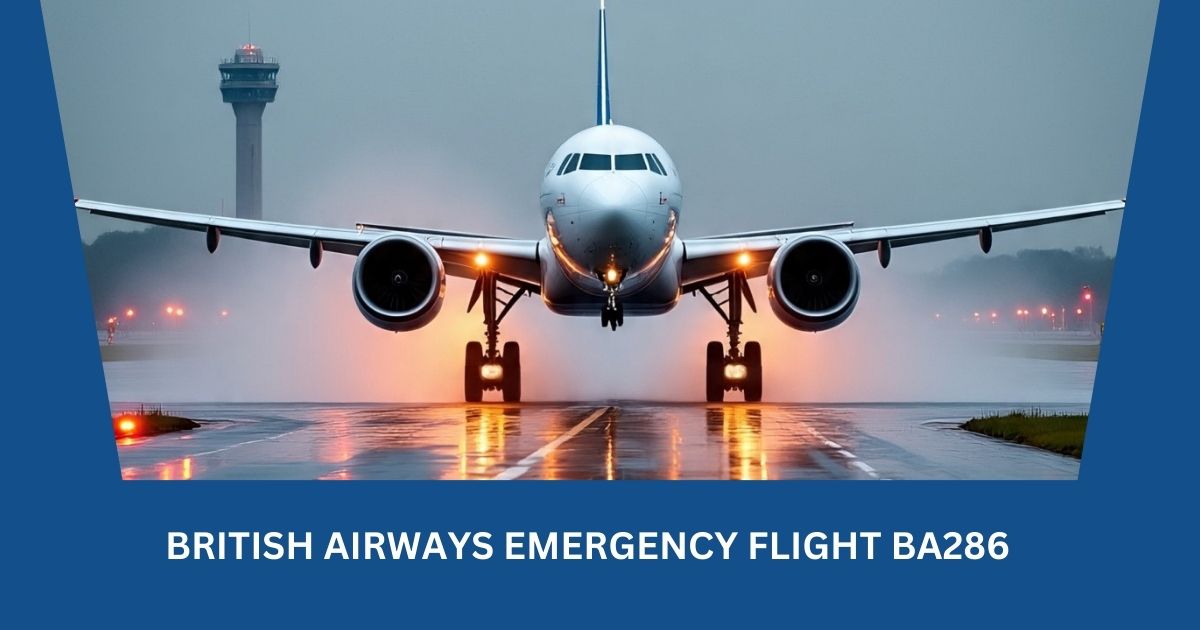Air travel has always been considered one of the safest modes of transportation, but emergencies can still occur, often requiring quick decision-making by pilots and airlines. One such incident that caught worldwide attention was the British Airways emergency flight BA286. Passengers, aviation enthusiasts, and news outlets closely followed the event, as emergency landings and diversions always create a mix of concern, curiosity, and analysis.
This article takes a closer look at the background of British Airways, what happened during the BA286 emergency, why such emergencies occur, and how airlines handle these situations while ensuring passenger safety.
Understanding British Airways
Before diving into the details of British Airways emergency flight BA286, it is important to understand the airline itself. British Airways (BA) is the flag carrier airline of the United Kingdom and one of the largest international airlines in the world. It operates flights to more than 160 destinations and has a long-standing reputation for safety, service, and global connectivity.
With decades of aviation experience, British Airways has a highly trained crew, strict safety protocols, and modern aircraft. However, even with these measures, emergencies can arise that require swift and professional responses.
What Happened with Flight BA286?
Flight BA286 was scheduled as a long-haul international service. During its journey, an unexpected situation forced the crew to declare an emergency. While details varied depending on initial reports, the fact remained clear: safety was the priority.
Passengers on board experienced a sudden announcement from the cockpit that the flight was being diverted. For many travelers, this was both alarming and reassuring—alarming because plans were disrupted, but reassuring because the airline was taking every precaution to ensure safety.
The headline “British Airways emergency flight BA286” spread quickly across aviation news platforms, making people wonder what caused the emergency and how passengers were affected.
Common Reasons for In-Flight Emergencies
While the specific reason behind British Airways emergency flight BA286 may not always be publicly disclosed in detail, there are several common causes that can trigger such situations:
1. Medical Emergencies
Long-haul flights often carry hundreds of passengers, and sometimes one may experience a severe medical condition such as a heart attack, stroke, or breathing difficulty. In such cases, the flight may need to land at the nearest suitable airport.
2. Technical or Mechanical Issues
Aircraft are highly advanced machines with multiple safety layers. Still, if an instrument shows irregularities or a component requires urgent attention, the crew may decide to divert as a precaution.
3. Smoke or Fire Alerts
Even the detection of smoke in the cabin or cockpit triggers immediate safety protocols, often leading to an emergency landing.
4. Weather-Related Challenges
Unstable weather, turbulence, or runway closures at the destination can also force a flight to divert unexpectedly.
5. Security Concerns
If a passenger displays unusual behavior or there is a potential security threat, airlines may opt to land early for everyone’s safety.
The case of BA286 likely involved one of these scenarios, which demonstrates how crucial quick decision-making is in aviation.
Passenger Experience During the Emergency
For passengers, being on board British Airways emergency flight BA286 was undoubtedly a stressful experience. Most people do not expect an emergency announcement mid-flight. Here’s what typically happens from a passenger’s perspective:
- Initial Announcement: The pilot informs passengers about the emergency or diversion, sometimes with limited details to avoid panic.
- Crew Preparation: Flight attendants ensure passengers remain calm, secure seat belts, and prepare for landing.
- Medical or Technical Focus: Depending on the emergency, doctors among passengers may be asked for assistance, or engineers may stand by at the diversion airport.
- Landing and Relief: Once the aircraft lands safely, passengers often feel an immense sense of relief despite the disruption.
While the experience can be unsettling, most passengers later appreciate how professionally the airline handled the situation.
How British Airways Handles Emergencies
British Airways, like all major airlines, follows strict aviation safety regulations. In the case of British Airways emergency flight BA286, the airline would have followed a clear protocol:
- Pilot’s Decision: The captain, in consultation with air traffic control, decides whether to divert or make an emergency landing.
- Coordination with Ground Teams: Emergency services and ground staff are alerted before the aircraft lands.
- Passenger Care: After landing, British Airways staff ensure passengers are informed, rebooked if needed, and provided with accommodation or meal vouchers if delays occur.
- Aircraft Inspection: The diverted aircraft undergoes immediate technical checks before it can return to service.
These steps show that safety comes before schedules or financial concerns.
Media and Social Media Coverage
The moment news broke about British Airways emergency flight BA286, media outlets began reporting. Flight tracking websites displayed the altered route, while passengers used social media to share real-time updates and videos from inside the cabin or the airport.
For aviation enthusiasts, these diversions are fascinating to study, while for passengers, they are lived experiences full of uncertainty. The combination of official updates and passenger accounts made BA286 a widely discussed event.
Impact on Passengers and Airline Operations
Emergencies like BA286 not only affect passengers but also have significant impacts on airline operations:
- Passenger Disruptions: Travelers miss connections, meetings, or personal events.
- Operational Costs: Emergency landings often mean additional fuel costs, crew overtime, and compensation for passengers.
- Aircraft Scheduling: A diverted plane may not return to service immediately, affecting other flights in the network.
- Reputation Management: Airlines must communicate clearly to maintain trust and transparency.
Despite these challenges, British Airways managed the situation professionally, reinforcing its image as a safety-first airline.
The Importance of Flight Safety Protocols
The British Airways emergency flight BA286 highlights the importance of strict flight safety measures. Airlines invest heavily in training pilots, flight attendants, and ground staff to respond effectively to emergencies.
Key safety measures include:
- Regular aircraft maintenance and inspections.
- Pilot and crew training in emergency procedures.
- Medical kits and defibrillators on board.
- Coordination with global air traffic control systems.
Such systems ensure that when emergencies occur, passengers are still protected.
Lessons for Passengers
While passengers cannot control flight emergencies, there are lessons to learn from incidents like BA286:
- Always follow crew instructions immediately.
- Keep essential items like medication in carry-on bags.
- Stay calm and trust the airline’s decision.
- Remember that diversions and emergency landings are for safety, not convenience.
These simple steps can make a difficult situation more manageable.
Final Thoughts
The incident involving British Airways emergency flight BA286 serves as a reminder that aviation, despite being the safest mode of transport, must always prepare for the unexpected. Emergencies like these are not failures but demonstrations of how well-trained crews and strict protocols keep passengers safe.
Passengers on BA286 likely felt unsettled in the moment but later realized how professionally the airline handled the emergency. For British Airways, it was another test of its commitment to safety and service, which it passed by prioritizing lives over logistics.
In the end, the story of British Airways emergency flight BA286 reinforces an important truth: flight safety is not just about technology but also about human judgment, training, and the unwavering focus on protecting passengers at all costs.




